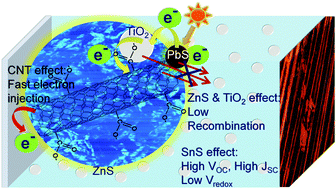当前位置:
X-MOL 学术
›
Phys. Chem. Chem. Phys.
›
论文详情
Our official English website, www.x-mol.net, welcomes your
feedback! (Note: you will need to create a separate account there.)
Solar cells with PbS quantum dot sensitized TiO2–multiwalled carbon nanotube composites, sulfide-titania gel and tin sulfide coated C-fabric
Physical Chemistry Chemical Physics ( IF 2.9 ) Pub Date : 2017-09-11 00:00:00 , DOI: 10.1039/c7cp05582j Ramesh K. Kokal 1, 2, 3, 4 , Melepurath Deepa 1, 2, 3, 4 , Ankarao Kalluri 5, 6, 7, 8, 9 , Shrishti Singh 5, 6, 7, 8, 9 , Isaac Macwan 5, 6, 7, 8, 9 , Prabir K. Patra 5, 6, 7, 8, 9 , Jeff Gilarde 9, 10, 11, 12
Physical Chemistry Chemical Physics ( IF 2.9 ) Pub Date : 2017-09-11 00:00:00 , DOI: 10.1039/c7cp05582j Ramesh K. Kokal 1, 2, 3, 4 , Melepurath Deepa 1, 2, 3, 4 , Ankarao Kalluri 5, 6, 7, 8, 9 , Shrishti Singh 5, 6, 7, 8, 9 , Isaac Macwan 5, 6, 7, 8, 9 , Prabir K. Patra 5, 6, 7, 8, 9 , Jeff Gilarde 9, 10, 11, 12
Affiliation

|
Novel approaches to boost quantum dot solar cell (QDSC) efficiencies are in demand. Herein, three strategies are used: (i) a hydrothermally synthesized TiO2–multiwalled carbon nanotube (MWCNT) composite instead of conventional TiO2, (ii) a counter electrode (CE) that has not been applied to QDSCs until now, namely, tin sulfide (SnS) nanoparticles (NPs) coated over a conductive carbon (C)-fabric, and (iii) a quasi-solid-state gel electrolyte composed of S2−, an inert polymer and TiO2 nanoparticles as opposed to a polysulfide solution based hole transport layer. MWCNTs by virtue of their high electrical conductivity and suitably positioned Fermi level (below the conduction bands of TiO2 and PbS) allow fast photogenerated electron injection into the external circuit, and this is confirmed by a higher efficiency of 6.3% achieved for a TiO2–MWCNT/PbS/ZnS based (champion) cell, compared to the corresponding TiO2/PbS/ZnS based cell (4.45%). Nanoscale current map analysis of TiO2 and TiO2–MWCNTs reveals the presence of narrowly spaced highly conducting domains in the latter, which equips it with an average current carrying capability greater by a few orders of magnitude. Electron transport and recombination resistances are lower and higher respectively for the TiO2–MWCNT/PbS/ZnS cell relative to the TiO2/PbS/ZnS cell, thus leading to a high performance cell. The efficacy of SnS/C-fabric as a CE is confirmed from the higher efficiency achieved in cells with this CE compared to the C-fabric based cells. Lower charge transfer and diffusional resistances, slower photovoltage decay, high electrical conductance and lower redox potential impart high catalytic activity to the SnS/C-fabric assembly for sulfide reduction and thus endow the TiO2–MWCNT/PbS/ZnS cell with a high open circuit voltage (0.9 V) and a large short circuit current density (∼20 mA cm−2). This study attempts to unravel how simple strategies can amplify QDSC performances.
中文翻译:

具有PbS量子点敏化的TiO 2-多壁碳纳米管复合材料,硫化物-二氧化钛凝胶和硫化锡涂覆的C-织物的太阳能电池
需要提高量子点太阳能电池(QDSC)效率的新颖方法。本文采用三种策略:(i)水热合成的TiO 2-多壁碳纳米管(MWCNT)复合材料代替传统的TiO 2;(ii)到目前为止尚未应用于QDSC的对电极(CE),即硫化锡(SnS)纳米颗粒(NPs)涂覆在导电碳(C)织物上,以及(iii)由S 2-,惰性聚合物和TiO 2纳米颗粒(与多硫化物相反)组成的准固态凝胶电解质基于溶液的空穴传输层。MWCNT凭借其高电导率和适当定位的费米能级(低于TiO 2的导带)和PbS)允许快速将光生电子注入外部电路,这可以通过TiO 2 -MWCNT / PbS / ZnS基(冠军)电池与相应的TiO 2 / PbS /相比获得的6.3%的更高效率来证实。ZnS基电池(4.45%)。TiO 2和TiO 2 -MWCNTs的纳米级电流图分析表明,后者中存在间距狭窄的高导电域,这使其具有的平均载流能力提高了几个数量级。电子传输和重组电阻是较低和较高分别为二氧化钛的2 -MWCNT / PBS /相对于二氧化钛的ZnS细胞2/ PbS / ZnS电池,从而导致高性能电池。SnS / C-fabric作为CE的功效已从使用CE的细胞与基于C-fabric的细胞相比获得的更高效率中得到证实。较低的电荷转移和扩散电阻,较慢的光电压衰减,较高的电导率和较低的氧化还原电势使SnS / C织物组件具有较高的催化活性以减少硫化物,因此使TiO 2 -MWCNT / PbS / ZnS电池具有高开口率电路电压(0.9 V)和较大的短路电流密度(〜20 mA cm -2)。这项研究试图揭示简单的策略如何扩大QDSC性能。
更新日期:2017-09-22
中文翻译:

具有PbS量子点敏化的TiO 2-多壁碳纳米管复合材料,硫化物-二氧化钛凝胶和硫化锡涂覆的C-织物的太阳能电池
需要提高量子点太阳能电池(QDSC)效率的新颖方法。本文采用三种策略:(i)水热合成的TiO 2-多壁碳纳米管(MWCNT)复合材料代替传统的TiO 2;(ii)到目前为止尚未应用于QDSC的对电极(CE),即硫化锡(SnS)纳米颗粒(NPs)涂覆在导电碳(C)织物上,以及(iii)由S 2-,惰性聚合物和TiO 2纳米颗粒(与多硫化物相反)组成的准固态凝胶电解质基于溶液的空穴传输层。MWCNT凭借其高电导率和适当定位的费米能级(低于TiO 2的导带)和PbS)允许快速将光生电子注入外部电路,这可以通过TiO 2 -MWCNT / PbS / ZnS基(冠军)电池与相应的TiO 2 / PbS /相比获得的6.3%的更高效率来证实。ZnS基电池(4.45%)。TiO 2和TiO 2 -MWCNTs的纳米级电流图分析表明,后者中存在间距狭窄的高导电域,这使其具有的平均载流能力提高了几个数量级。电子传输和重组电阻是较低和较高分别为二氧化钛的2 -MWCNT / PBS /相对于二氧化钛的ZnS细胞2/ PbS / ZnS电池,从而导致高性能电池。SnS / C-fabric作为CE的功效已从使用CE的细胞与基于C-fabric的细胞相比获得的更高效率中得到证实。较低的电荷转移和扩散电阻,较慢的光电压衰减,较高的电导率和较低的氧化还原电势使SnS / C织物组件具有较高的催化活性以减少硫化物,因此使TiO 2 -MWCNT / PbS / ZnS电池具有高开口率电路电压(0.9 V)和较大的短路电流密度(〜20 mA cm -2)。这项研究试图揭示简单的策略如何扩大QDSC性能。









































 京公网安备 11010802027423号
京公网安备 11010802027423号